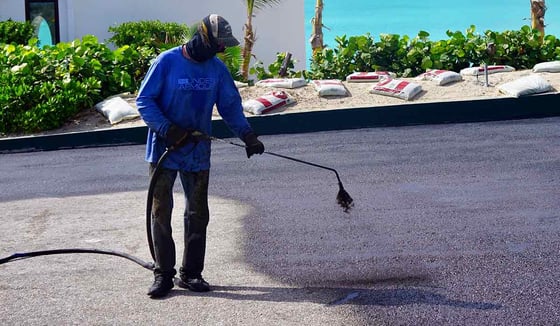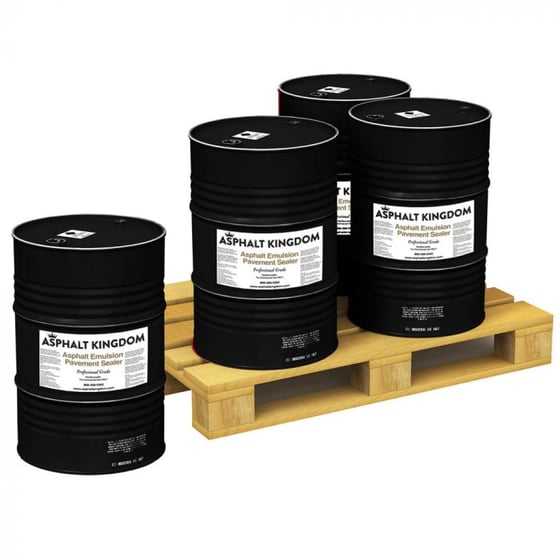- Learn about asphalt emulsion and why it plays a big part in road construction, asphalt maintenance, and more.
- Discover how this environment-friendly substance is manufactured and how it works.
- Asphalt emulsion has a myriad of benefits, including cost-efficiency, versatility, and improved safety.
Asphalt emulsion is a substance made up of water, asphalt binder, and an emulsifying agent.
This mixture is composed of tiny asphalt droplets suspended in water. The emulsifying agent, usually a surfactant, keeps the asphalt droplets in a stable suspension, preventing them from coalescing.
When the emulsion is applied to a surface and the water evaporates, the asphalt particles coalesce, forming a continuous asphalt layer.
Table of Contents- The Role Asphalt Emulsion Plays in Modern Construction Practices
- Asphalt Emulsion: What it's Made Of
- The Asphalt Emulsion Manufacturing Process
- Classifications of Asphalt Emulsion
- Influence of Polymers and Latex in Asphalt Emulsion
- Adaptability and Flexibility of Asphalt Emulsion
- Environmental Benefits of Using Asphalt Emulsion
- Asphalt Emulsion Applications and Advantages
- Asphalt Emulsion FAQs
The Role Asphalt Emulsion Plays in Modern Construction Practices
Asphalt Kingdom Asphalt Emulsion Sealer
Asphalt emulsion has become integral to modern construction for several reasons. These include
- Environmental Benefits. Asphalt emulsion reduces the need for high-temperature mixing and laying, thus decreasing energy consumption and harmful emissions.
- Versatility. They can be used for a variety of applications including tack coats, seal coats, surface treatments, and cold mix asphalt.
- Cost-Efficiency. It can be applied in thinner layers, saving on material costs. They also reduce the need for expensive heating equipment.
- Recycling. It plays a crucial role in cold-in-place and full-depth reclamation processes, allowing existing pavement materials to be reused.
- Safety. Reduced heating eliminates the risk of burns and decreases the release of fumes, ensuring safer working conditions.
Asphalt Emulsion: What it's Made Of
 Applying Asphalt Emulsion Sealer
Applying Asphalt Emulsion Sealer
👉 Liquid Asphalt Cement
Asphalt cement is a heavy, sticky, black semi-solid, or liquid substance derived from crude oil.
It is the adhesive "glue" that, when mixed with aggregates (like stones and sand), creates the asphalt mix used for paving.
Its thick and viscous nature allows it to act as a durable binder, providing strength and flexibility to pavements.
Related: 11 Questions to Ask an Asphalt Maintenance Contractor Before You Hire One
👉 Water
Water acts as the carrier for the asphalt particles in an emulsion. It facilitates the distribution and application of the asphalt onto the required surfaces.
After the emulsion is applied, the water evaporates, leaving behind the asphalt to bond with the aggregate or surface.
👉 Emulsifying Agents
These are specialized chemicals or surfactants that allow the asphalt and water, which are naturally immiscible (they don't mix), to be stabilized in a mixed state. Think of it like how egg yolk acts in mayonnaise, preventing the oil and vinegar from separating.
How Do Emulsifying Agents Work?
Imagine you're trying to mix oil and water. On their own, they separate, with oil floating on top because they don’t naturally combine. An emulsifying agent acts as a mediator, allowing these two to coexist in a stable mixture.
In the context of asphalt emulsion, the emulsifying agents surround the tiny droplets of asphalt, creating a protective barrier that prevents these droplets from joining together and separating from the water.
These protective barriers also carry a charge, which ensures that the droplets repel each other rather than clustering together. It's similar to how magnets with the same poles repel one another.
As a result, the asphalt droplets remain finely dispersed throughout the water, forming a stable emulsion.
The Asphalt Emulsion Manufacturing Process
A colloid mill is a machine used to reduce the size of asphalt cement particles to create a stable mixture with water. Here's a step-by-step breakdown of the process.
 Asphalt sealer being applied
Asphalt sealer being applied
Preparation
The basic ingredients — liquid asphalt cement, water, and emulsifying agents — are prepared. Their quantities are decided based on the desired properties of the final emulsion.
Feeding into the Colloid Mill
The asphalt cement is pumped into the mill at a high temperature to keep it in a liquid state. Simultaneously, the water mixed with the emulsifying agents is also introduced.
Size Reduction and Mixing
Inside the colloid mill, there are rotating parts and static parts with very close clearances between them. As the ingredients pass through, the asphalt is broken down into tiny droplets.
These droplets are immediately coated by the emulsifying agents and suspended in water.
Output
The resulting mixture that comes out of the colloid mill is a fine dispersion of asphalt droplets in water, which is the asphalt emulsion.
Related: How to Fill a Pothole in 4 Steps
The Importance of Water Quality and Chemical Emulsifiers
The water used in the mixture should be clean and free from impurities. Contaminants or minerals in water can react with the emulsifying agents or asphalt, leading to unstable emulsion that can break or separate.
The pH level of the water can also influence emulsion stability. That’s why in many instances, distilled or deionized water is preferred.
Chemical Emulsifiers
The choice and amount of emulsifying agents are crucial. These agents determine how quickly the emulsion breaks and sets after being applied.
They also influence the stability of the emulsion during storage. Selecting the right emulsifier ensures that the asphalt droplets remain uniformly dispersed in the water and that the emulsion behaves as desired during application.
Additional Ingredients for Modifying the Emulsion's Physical Characteristics
Beyond the primary components, other ingredients can be added to modify the physical properties of the emulsion:
- Stabilizers. These compounds can be added to enhance the storage life of the emulsion and improve dispersion.
- Modifiers. Polymers or latex can be introduced to improve the elasticity, adhesion, and overall performance of the emulsion.
- Anti-stripping Agents. These can enhance the bonding between the asphalt and aggregates, especially in the presence of water.
Classifications of Asphalt Emulsion
Asphalt emulsion is classified based on the ionic charge they carry, which can significantly impact their compatibility with aggregates. These include:
- Cationic. This type of emulsion has a positive charge. It is used mainly with negatively charged aggregates, which are common in many regions.
- Cationic emulsion tends to break or set more quickly than anionic ones because of the attraction between the opposite charges of the emulsion and the aggregate.
- Anionic. This asphalt emulsion has a negative charge and is suitable for use with positively charged aggregates. Anionic emulsion was more popular in earlier road construction. But it has been largely replaced by cationic emulsion in many applications.
- Non-ionic. It has no net charge and is less common than the other two types. Its setting mechanism does not rely on ionic interaction with the aggregates.
Significance of Rapid Set, Medium Set, Slow Set, and Quick Set Designations
These designations refer to the setting behavior and viscosity of the emulsion:
☑️ Rapid Set (RS). This emulsion breaks rapidly and is used for quick applications like chip seals. RS emulsion resists water damage and is best for open-graded mixes.
☑️ Medium Set (MS). With an intermediate setting rate, MS emulsion is used in mixing operations like patching mixes in shallow pavement areas.
☑️ Slow Set (SS). This emulsion sets more slowly and ideal for fog seals, slurry seals, and tack coats. SS emulsion has time to spread and coat before breaking.
☑️ Quick Set (QS). QS emulsion is designed to set quickly and is useful in applications similar to rapid set emulsion but can be formulated to provide a longer mixing time.
Benefits of High Float Emulsion
High-float emulsion has a unique property. They form a gel structure upon contact with aggregates, ensuring a thicker asphalt layer around the aggregate particles. This enhances the adhesion between the asphalt and the aggregate.
Take a look at the other benefits below.
- Better Adhesion. The thicker asphalt film reduces the chances of stripping.
- Flexibility. The thicker film can better accommodate movement and stresses, reducing the likelihood of cracking.
- Water Resistance. High float emulsion is more resilient against water infiltration and damage.
Usage in Specific Conditions
High float emulsion is particularly beneficial in conditions where superior adhesion and water resistance are vital.
This includes areas with high rainfall, pavements with a history of stripping issues, or colder climates where freeze-thaw cycles can challenge the integrity of pavements.
When added to asphalt emulsion, polymer, and latex, they play an influential role in enhancing the overall properties of the resultant pavement.
Their introduction into the mixture brings about significant changes to the asphalt’s behavior and characteristics, making it more adaptable and resilient.
🔷 Strength and Elasticity. Polymers act as elastic modifiers. When added to the asphalt, they form a network structure, enhancing the binder's elasticity and memory.
This means that the pavement can deform under heavy loads and then return to its original shape once the load is removed. An increased elastic response helps the pavement resist permanent deformation, such as rutting.
🔷 Adhesion. Polymers, especially certain types of latex, enhance the adhesion between the asphalt binder and the aggregates.
This improved adhesion reduces the risk of stripping, where the binder might separate from the aggregates, especially in the presence of moisture. Enhanced adhesion ensures a longer-lasting pavement with fewer maintenance needs.
🔷 Durability. Polymers can act as antioxidants, slowing down the aging process of the asphalt binder. The oxidation process in asphalt leads to hardening and eventually, brittleness.
Polymers can delay this, ensuring the pavement remains flexible and resilient.
Related: 5 Benefits of Using Asphalt Crack-Filling Equipment
Influence of Polymers and Latex in Asphalt Emulsion
 Driveway Sealing with Asphalt Emulsion
Driveway Sealing with Asphalt Emulsion
Temperature fluctuations can cause several distresses in pavements, including thermal cracking and rutting. Polymers assist in mitigating these distresses:
☑️ Resistance to Cracking. At low temperatures, traditional asphalt can become brittle and susceptible to thermal cracking due to contraction.
Polymer-modified asphalts have a lower stiffness at these temperatures, making them more flexible. This increased flexibility means that the pavement can contract and expand with temperature changes without cracking.
☑️ Resistance to Rutting. At high temperatures, especially during peak summer, traditional asphalt pavements can become soft and start to rut under the repetitive loads of traffic.
Rutting is a surface depression in the wheel path. Polymer-modified asphalts have a higher softening point, making them more resistant to this kind of deformation.
Their elastic nature ensures they spring back to their original shape, even after being subjected to heavy loads.
Adaptability and Flexibility of Asphalt Emulsion
Asphalt emulsion offers a distinct advantage: the ability to be modified according to specific needs. This adaptability ensures that the emulsion fits the exact requirements of the project in hand, optimizing various aspects of the pavement process.
🔷 Storage. By tweaking the formula, emulsion can be stabilized for longer storage periods. This means that there's a reduced need for just-in-time production, allowing flexibility in supply chain management.
🔷 Curing. The break or set time of an emulsion, which is when the water evaporates leaving behind the asphalt binder, can be adjusted.
For some projects, a quick set is necessary, while in other instances, a slower cure might be desired for extended working times.
🔷 Mixing. Asphalt emulsion can be formulated for compatibility with a range of aggregate types and sizes. This ensures that the mix quality remains consistent, with proper coating and bonding.
🔷 Traffic Return. Depending on the application, the emulsion can be designed to accommodate traffic sooner or later. For high-traffic areas or projects with tight timelines, quick traffic return is a huge advantage.
Charge Compatibility with Aggregates
The ionic charge of an emulsion - positive (cationic), negative (anionic), or neutral (non-ionic) - has significant implications for its compatibility with aggregates.
 Aggregates used for road, parking lot, and driveway construction (Photo by Nadin Mario on Unsplash)
Aggregates used for road, parking lot, and driveway construction (Photo by Nadin Mario on Unsplash)
☑️ Positive (Cationic) Charges. Cationic emulsion tends to adhere better to most aggregates, which often carry a negative charge. This ensures stronger bonding and reduced stripping, making cationic emulsion popular in many applications.
☑️ Negative (Anionic) Charges. Anionic emulsion is suitable for specific types of aggregates that have a positive charge. While less common than cationic emulsion, it serves essential functions in particular regional contexts where such aggregates prevail.
☑️ Neutral (Non-ionic) Charges. This type of emulsion does not rely on ionic interactions to bond with aggregates. They're less common but can be useful in specialized scenarios.
The Adaptability of Asphalt Emulsion to Various Conditions and Applications
The beauty of asphalt emulsion lies in its versatility. Depending on the project's specific needs, it can be modified to:
- Weather and Climate. Asphalt emulsion can be tailored for cold climates, where flexibility at low temperatures is crucial, or for hotter climates, where resistance to rutting is vital.
- Surface Type. Whether it's a dense-graded road surface, an open-graded friction course, or a micro-surfacing application, asphalt emulsion can be modified to fit the purpose.
- Maintenance and Repair. It for pothole patching can be designed to set quickly, while those for sealcoat might be optimized for better penetration and sealing properties.
Environmental Benefits of Using Asphalt Emulsion

The shift towards more sustainable and environmentally-conscious construction practices has bolstered the appeal of asphalt emulsion. They present numerous advantages that are both ecologically and economically beneficial.
🔹 Minimal Hydrocarbon Emissions. Traditional hot-mix asphalt requires high temperatures for production and application.
These temperatures can result in the release of significant hydrocarbon emissions, contributing to air pollution. In contrast, asphalt emulsion is applied at much lower temperatures, dramatically reducing these emissions.
🔹 Reduced Energy Consumption. Since asphalt emulsion can be produced and applied at ambient or mildly elevated temperatures, there's a significant reduction in the energy required to heat them compared to hot-mix asphalt.
This translates to less fuel consumption, which not only reduces costs but also decreases the carbon footprint of road construction projects.
🔹 Remote Location Applications. In remote locations where setting up a hot mix plant might be challenging or not cost-effective, asphalt emulsion presents a viable alternative.
Its ambient temperature application means that roads can be constructed or maintained without the need for heavy equipment or energy-intensive processes.
🔹 Role in Recycling Systems. Asphalt emulsion plays a crucial role in cold in-place recycling (CIR) and full-depth reclamation (FDR).
In these processes, the existing asphalt pavement is milled, mixed with an emulsion, and then laid back down. This reduces the need for new aggregates and binders, conserving natural resources.
The energy and emissions associated with extracting, producing, and transporting new materials are also saved.
🔹 Water-Based Systems. Asphalt emulsion is predominantly water-based, which means it contains fewer volatile organic compounds (VOCs) than solvent-based systems. This results in a reduction of VOC emissions which can contribute to smog formation.
🔹 Reduced Resource Extraction. By maximizing the use of recycled materials in certain emulsion-based applications, there's a decreased demand for virgin aggregates and binders.
This reduces the environmental impacts associated with resource extraction.
🔹 Versatility in Repairs. Asphalt emulsion can be used for a variety of maintenance activities, including patchwork, sealcoating, and micro-surfacing.
This versatility means that road or parking lot lifespan can be extended with minor interventions, reducing the frequency of more resource-intensive overhauls.
Related: Starting a Sealcoating Business: 15 Tips For Success
Asphalt Emulsion Applications and Advantages
☑️ Surface Treatments. Asphalt emulsion can be used as a protective layer on roads or as a sealant to fill cracks or rejuvenate older roads. These surface treatments can prolong the life of the existing pavement.
👉 Chip Seal. An application of asphalt emulsion followed by a layer of crushed stone or gravel. Once the stone or gravel is compacted, it provides a new wearable surface.
👉 Fog Seal. A light application of diluted asphalt emulsion to restore flexibility to old, oxidized pavement.
👉 Sand Seal. A layer of asphalt emulsion followed by a covering of sand to improve skid resistance.
☑️ Cold Recycling. This is a method of rehabilitating an existing pavement by milling or pulverizing the old pavement and mixing it with an asphalt emulsion. The mix is then placed and compacted.
☑️ Micro-Surfacing. A mixture of dense-graded aggregate, polymer-modified asphalt emulsion, water, and mineral fillers. It's a form of cold mix that can correct rutting and improve the road surface's skid resistance.
☑️ Slurry Seals. A mixture of emulsified asphalt, well-graded fine aggregate, mineral filler, and water. It's a cold-mix application that restores a smooth surface to oxidized or worn-out pavements.
☑️ Cold Mix. Used primarily for patching potholes, this mix can be stockpiled and used as needed. It's produced by mixing emulsified asphalt with cold, wet aggregates.
☑️ Tack Coats. Used between layers of asphalt to ensure a good bond.
☑️ Dust Control. Applying a diluted asphalt emulsion to unpaved roads to reduce dust.
☑️ Prime Coats. Applied to untreated base materials to provide a waterproof surface and a bond between the base and the overlay.
Advantages Over Traditional Hot Mix Asphalt
- Temperature Flexibility. Since they can be applied at ambient temperatures, asphalt emulsion can be used in a wider range of temperatures compared to hot mix asphalt, which needs to be heated.
- Improved Skid Resistance. Surface treatments using asphalt emulsion can improve skid resistance, providing safer driving conditions.
- Reduced Hydroplaning. Textured surfaces made with emulsion reduce the potential for hydroplaning in wet conditions.
- Lower Life-Cycle Costs. When utilized correctly, emulsion treatments can extend the pavement life, thus reducing the overall life-cycle cost of the pavement.
- Environmentally Friendly. Asphalt emulsion can be produced and applied at lower temperatures, which reduces energy consumption and emissions.
- Reduced Reflective Cracking. Cold recycling and certain surface treatments with emulsion can reduce or delay reflective cracking.
- Resource Conservation. Cold recycling with emulsion utilizes existing materials, conserving natural resources.
- Enhanced Workability. Asphalt emulsion can be used in various mix designs, making them flexible for a range of projects and conditions.
- Prolonged Pavement Life. Several applications of asphalt emulsion serve to protect the pavement, enhancing its durability and lifespan.
Related: 6 Reasons to Start a Driveway Sealing Business
Asphalt Emulsion FAQs
What are the different types of asphalt emulsion, and how are they classified?
Asphalt emulsion is a mixture of asphalt, water, and an emulsifying agent. They're classified into three main types: anionic, cationic, and non-ionic, based on the electrical charge of the particles.
What are the advantages of using asphalt emulsion in construction and road maintenance?
Asphalt emulsion is cost-effective, can be applied at lower temperatures, offer good binding properties, and can rejuvenate older pavements.
Does Asphalt Kingdom sell asphalt emulsion sealer?
Yes. Asphalt Kingdom sells asphalt emulsion sealer in 55-gallon drums and skids. Buyers can also purchase asphalt emulsion sealer in a 275-gallon tote or have it delivered by bulk tanker.
 Asphalt Emulsion Sealer
Asphalt Emulsion Sealer
| Asphalt Kingdom Asphalt Emulsion Sealer | Price* |
| Asphalt Emulsion Sealer (55 Gallon Drums) | $589.00 |
| Asphalt Emulsion Sealer Skid (Four 55 Gallon Drums) | $1,569.00 |
| 4 Asphalt Emulsion Sealer Skids (16 x 55-Gallon Drums) | $5,779.00 |
| Asphalt Emulsion Sealer (275 Gallon Tote) | $1,649.00 |
| Asphalt Emulsion Sealer Bulk Buy (4) 275 Gallon Totes | $6,199.00 |
| Asphalt Sealer: Bulk Tanker Load | Call for information |
* Prices are subject to change without prior notice
Want to purchase asphalt emulsion sealer but don't know how much you're going to need? Use Asphalt Kingdom's Blacktop Calculator to determine how much driveway sealer you're going to need for the job.
Is asphalt emulsion environmentally friendly, and how do they contribute to sustainability?
Yes, asphalt emulsion is environmentally friendly. It contains fewer volatile organic compounds (VOCs), and its production and application consume less energy and produce fewer emissions than hot mix asphalt, contributing to sustainability.
Can asphalt emulsion be used in various weather conditions, including cold and wet environments?
Asphalt emulsion can be applied in various weather conditions, including colder and wetter environments, making them versatile for diverse climates.
What are the key applications of asphalt emulsion in road construction and preservation?
It is used in surface treatments (like chip seals and fog seals), cold mix for patching, and cold recycling. It is also used for micro-surfacing, slurry seals, and tack coats in road construction and preservation.
How does asphalt emulsion improve the performance and longevity of parking lots and driveways?
Asphalt emulsion enhances safety by improving skid resistance and reducing cracking, ultimately extending the life of road surfaces.
Conclusion:
Thanks for reading this comprehensive guide on asphalt emulsion and its application in the industry. If you're ready to purchase your first drum or tote of asphalt emulsion sealer, then check out the Asphalt Kingdom store.
Whether you're a new contractor who's looking for a drum of sealer or you need an entire tanker of sealer delivered to your doorstep, we've got the right product for you.
If you need help choosing the right asphalt sealer quantity, feel free to reach out to us at 1-866-399-5562 or sales@asphaltkingdom.com.






